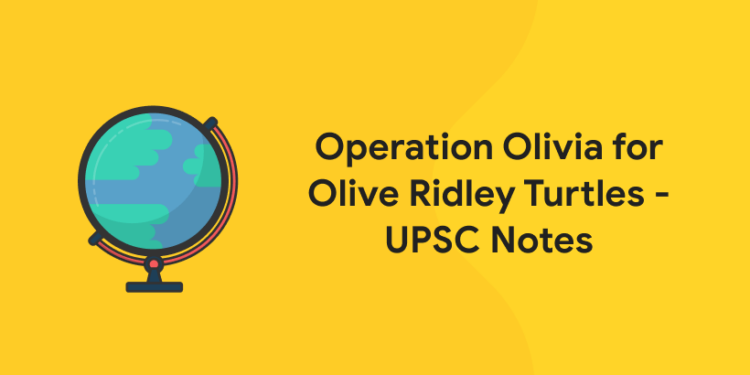Table of Contents
An aircraft has been put into service by the Indian Coast Guard, Search and Rescue, and Maritime Law Enforcement agency under the Ministry of Defence for “Operation Olivia” to safeguard Olive Ridley turtles. The main intention is to safeguard the Olive Ridley turtle population from December to May, when they lay their eggs. The turtles’ primary habitat range, off the coast of Odisha, is where it takes place.
More information on Operation Olivia in relation to the Civil Services Exam will be provided in this post.
Attempt Free GK Mock test ! Download Entri App!
Operation Olivia
Early in the 1980s, the Indian Coast Guard began Operation Olivia. The operation’s goal is to save Olive Ridley turtles when they migrate to the coast of Odisha from November to December in order to reproduce and lay their eggs. Every year, Olive Ridley turtles are protected throughout their breeding seasons and their environment is preserved through Operation Olivia.
ICGs from India carry out this mission. Indian Coast Guards conducts round-the-clock surveillance as part of the mission. In order to police the law near the rookeries, the Indian Coast Guard is using resources including swift patrol vessels, air cushion vessels, interceptor craft, and Dornier aircraft. The Coast Guard invested 388 aircraft hours and 225 ship days between November 2020 and May 2021. 3.49 lakh turtles have been safeguarded.
In cooperation with the Indian Coast Guard and the state of Odisha forest department, it was inaugurated in December 2020. For this conservation project, two coast guard vessels and a few planes have been allocated. The coast guard ships will make sure that no fishing boats access the areas that are known as breeding grounds, such as the Dhmara River and Rushikulya Beach. The state of Odisha has outlawed fishing in the area of these monuments.
These laws and operation are enforced by the Coast Guard which gets power under Orissa Marine Fisheries Act. Efforts are made at various levels such as:
- Enforcement of use of Turtle Excluder Devices (TED) by trawlers in waters surrounding nesting areas.
- Prohibition of using gill nets as turtle approaches to the shore to curtail turtle poaching.
Grab Study Materials to Strengthen your Knowledge in GK!! Register Here!
About Olive Ridley Turtles
The Olive Ridley turtle is the tiniest and most prevalent sea turtle in the world. These turtles are carnivores, and their name comes from the colour of their carapace, which is olive. They are most known for their distinctive Arribada mass nesting, in which a large number of females congregate to lay eggs on a single beach.
Feature of Olive Ridley Turtle
- Scientific Name – Lepidochelys olivacea
- Family – Cheloniidae
- Mass Nesting – Arribada
- They are found in warm waters of the Pacific, Atlantic, and Indian oceans.
- The Olive Ridley sea turtle is named after its olive-colored, rounded, heart-shaped carapace, which grows to a length of around 61 cm (2 ft) when measured along the curve.
- These turtle species produce dark grey hatchlings. The hatchlings have carapace lengths between 37 and 50 mm.
- In relatively shallow marine environments, Olive Ridley Turtles can be found all throughout the world.
- Over the course of a year, they travel thousands of kilometres between feeding and breeding locations.
Nesting Habitat of Olive Ridley Turtle
- Olive ridley turtles have a unique habit of mass nesting called Arribada. Under this, thousands of female turtles come together on the same beach to lay eggs.
- There are three arribada beaches along the Odisha coast, one each in Gahirmatha, the Devi river mouth, and Rushikulya, where a reported 1 lakh nests are discovered each year.
- In the Andaman and Nicobar Islands, a new mass nesting location has recently been found. According to accounts, it has around 5,000 nests in a season.
- “Sea turtles often return to their natal beach, or where they were born, to lay eggs as adults,” the Coast Guard official said.
- Females visit the breeding grounds’ offshore waters for mating and come onshore multiple times to lay their eggs throughout the breeding season.
- They scurry onto the coast and dig a 1.5–2 foot deep flask-shaped nest. Lay between 100 and 150 eggs every clutch.
- Hatchlings leave their nests together after 7 to 10 weeks.
- The officer continued, “They face a number of difficulties between the mother’s arrival and the hatchlings’ withdrawal to the sea. Only one out of every thousand children is thought to live to adulthood.
Attempt Free GK Mock test ! Download Entri App!
Threat of Olive Ridley Turtle
- Turtles are seriously threatened by intensive fishing activity, including as ocean-going trawlers, mechanised fishing boats, and gill-netters, off the coasts of Andhra Pradesh, Odisha, and West Bengal.
- Typically, they are poached for their meat, shell, and eggs.
- Increasing trash dumped by visitors and fishermen, including plastics, fishing nets, discarded nets, polythene, and waste.
Protection of Olive Ridley Turtle
- According to the Red List of the International Union for Conservation of Nature (IUCN), Olive Ridley turtles are classified as vulnerable.
- The Indian Wildlife Protection Act of 1972 includes sea turtles discovered in India under Schedule I.
- They are also included in CITES’ Appendix I, which lists wild fauna and flora that are protected from commercial trade. The Appendix I of the Convention on International Trade in Endangered Species, which forbids signatory nations from trading in turtle products, also lists these five species.
- The Orissa Marine Fisheries Act, which designates the Coast Guard as one of its enforcement authorities, and laws for the protection of Olive Ridley turtles have also been created by the state of Odisha.
- “Studies have revealed three key reasons that impair Olive Ridley turtles and their eggs,” the Coast Guard officer stated. “These are excessive predation of eggs by dogs and other animals, indiscriminate fishing with trawlers and gill nets, and beach soil erosion.”
The necessity of Operation Olivia
- Firstly, eggs of Olive Ridley Turtles damaged: Damage to Olive Ridley turtles and their eggs is mostly caused by three things,
1. Heavy predation of eggs by dogs and wild animals,
2. Indiscriminate fishing with trawlers and gill nets and
3. beach soil erosion
- Secondly, there is extensive fishing along the coasts of West Bengal, Odisha, and Andhra Pradesh.
- Thirdly, nesting beaches are being developed and used as tourist destinations and ports.
- Lastly, poaching an animal for its meat, shell, or leather.
Olive Ridley It’s time for people to take action since the turtle is in danger of being extinct. Pigs, ghost carbs, feral dogs, and other predators frequently prey on the hatchlings of the turtle since they lack the strength to defend themselves.
Marine predators like whales, sharks, and others are known to attack turtles out at sea. Olive Ridley turtle postulations numbers have rapidly decreased as a result of illegal turtle flesh harvesting and human egg poaching. In these circumstances, the Indian government or other relevant authorities must take the appropriate actions to protect this species of turtle.
Attempt Free GK Mock test ! Download Entri App!
Operation Olivia for Olive Ridley Turtles – UPSC Notes Download PDF
1: Who was the first woman President of India?
Here you can download the Operation Olivia for Olive Ridley Turtles UPSC notes Pdf which will be very effective in the preparation of upcoming UPSC examination.
Download Entri App, Start using Entri App to get ready for your ideal government job.. We give you a tonne of resources for all of the courses and government tests. We are offering you the top platform for getting ready for each esteemed exam. You can access a variety of practise exams here, where you can also find daily GK and current events practise questions. for those studying for competitive exams such as Bank Exams, UPSC Exams, and other Government Exams. A static truth is one that won’t change in the future, hence static GK refers to general knowledge regarding those facts.












